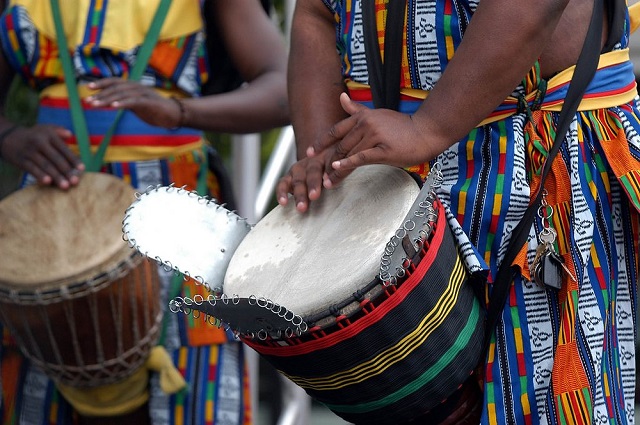
African music includes Afrobeat, Fuji, Highlife, Makossa, Kizomba, and Juju and Juju-influenced genres, including Juju and Fuji. In West African music, Sylviane Diouf and ethnomusicologist Gerhard Kubik claim that Muslim regions incorporate elements of Islamic music, whereas non-Muslim areas are more affected by indigenous traditions.
According to Sylviane Diouf and Gerhard Kubik, Muslim countries absorb elements of Islamic music, whereas indigenous traditions more influence non-Muslim regions.
“Words that seem to quiver and shake” the vocal cords, dramatic changes in musical scales, and nasal intonation are all part of traditional Muslim West African music. The Islamic call to prayer is also incorporated into this music, first performed by an Abyssinian African Muslim named Bilal ibn Rabah in the early 7th century.
Muslim West African singers “employ melisma, wavy intonation, and so forth” as a remnant of the region’s contact with the Maghreb’s Arabic-Islamic civilization from the seventh and eighth centuries, according to Kubik. Check out the latest celebrities’ biographies.
According to Kubik, Muslim West Africans traditionally preferred stringed instruments (including the forebears of the banjo), whereas non-Muslim West Africans preferred drumming as an instrument.
African traditional music instruments include:
- Djembes.
- Water drums.
- Bougarabous, Ngoma drums (or engoma drums) in West Africa.
- Several varieties of Ngoma drums in Central and Southern Africa.
The other percussion instruments offered include the kosika (kashaka), rain sticks, bells, and wood sticks. Different varieties of drums, flutes, and strung and wind instruments can also be found in Africa.
One of the most general aspects of Sub-Saharan music is polyrhythms, which is also one of its most distinguishing characteristics. To be able to play numerous rhythms at the same time, various instruments have been created expressly for this purpose.
Some instruments, such as the mbira, kalimba, kora, ngoni, and dousn’gouni, arrange notes, not in a single linear sequence from bass to treble but instead in two different rank arrays, making it easier to play cross-rhythms. American devices of the twentieth century show that this theory is still relevant. Gravi-kora and gravikord are examples of new modern manifestations of this principle.
History
It’s no secret that African music has undergone some crucial alterations. The music of Africa today may be very different from the music of Africa in the past. Furthermore, there has never been a time when African music was exclusively linked with a single ethnic group. The unique voice of the musician and his or her style and originality have always been important in the music business.
Other material sources include archaeological and other artefacts, pictorial sources such as petroglyphs and rock drawings and written accounts of African travels, field notes written in African or European languages, musical notations, and photographs videotapes that can be used for the study of African music history.
According to historical documents, the musical traditions of Sub-Saharan Africa formerly spread as far north as North Africa. Climate changes in the Sahara between 8000 and 3000 BC allowed savanna vegetation and wildlife to extend into the southern and central regions of the Sahara and its mountains.
When humans settled in the Sahara, they began to spread along rivers and tiny lakes, bringing Neolithic, or New Stone Age, cultures with a so-called aquatic lifestyle. If you are a Nigerian, get the latest Big Brother Naija updates here.
A slow breakdown of aquatic cultures occurred between 5000 and 3000 BC when the wet period’s pinnacle had passed. Due to global warming, the damp climate became increasingly restricted to diminishing lakes and rivers and the upper Nile region. In the Lake Chad region and the Nile wetlands, remnants of the old civilization can still be found.
Rock paintings from the “Green Sahara” region are a treasure trove of iconographic material, including some of the first internal sources on African music. An anthropologist who studied Algeria’s Tassili n’Ajjer plateau in 1956 discovered a flourishing dancing culture that is still there today. Based on stylistic factors, this painting has been dated to the Neolithic hunter period in the Sahara (c. 6000–4000 BC), making it one of the earliest examples of music and dancing in Africa. Several African civilizations’ body ornamentation and movement style are represented in their traditional dance traditions.


